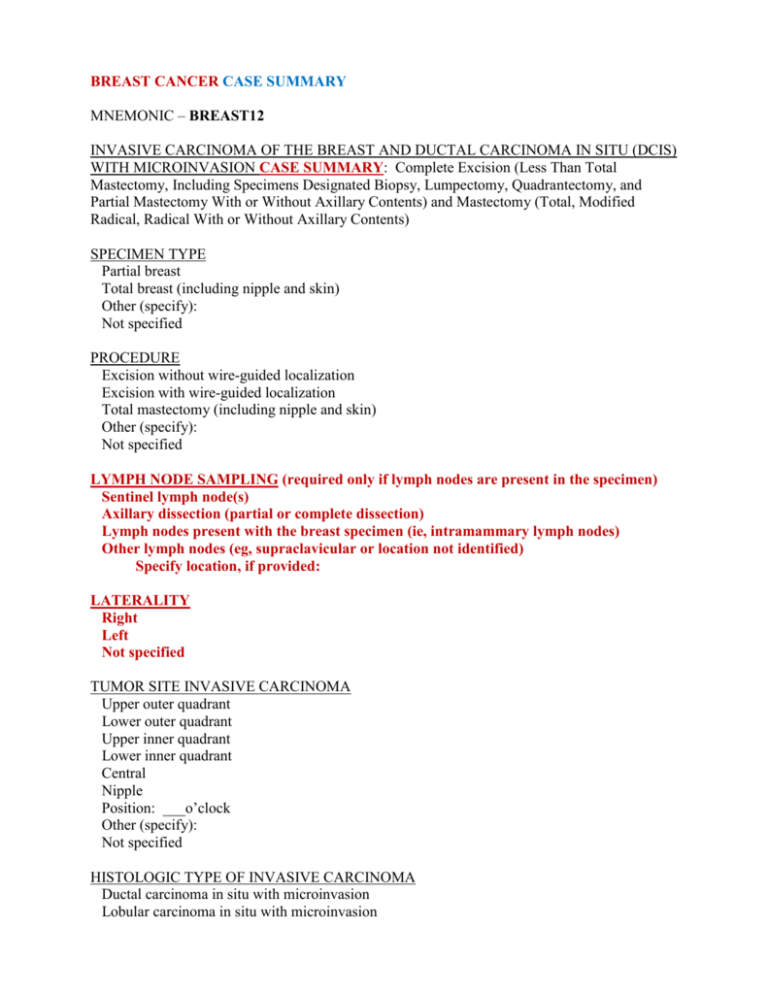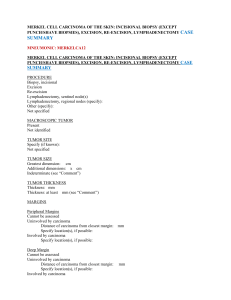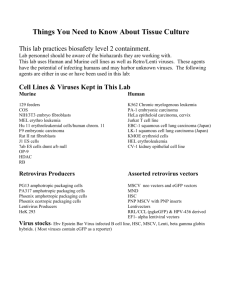Breast Invasive Carcinoma
advertisement

BREAST CANCER CASE SUMMARY MNEMONIC – BREAST12 INVASIVE CARCINOMA OF THE BREAST AND DUCTAL CARCINOMA IN SITU (DCIS) WITH MICROINVASION CASE SUMMARY: Complete Excision (Less Than Total Mastectomy, Including Specimens Designated Biopsy, Lumpectomy, Quadrantectomy, and Partial Mastectomy With or Without Axillary Contents) and Mastectomy (Total, Modified Radical, Radical With or Without Axillary Contents) SPECIMEN TYPE Partial breast Total breast (including nipple and skin) Other (specify): Not specified PROCEDURE Excision without wire-guided localization Excision with wire-guided localization Total mastectomy (including nipple and skin) Other (specify): Not specified LYMPH NODE SAMPLING (required only if lymph nodes are present in the specimen) Sentinel lymph node(s) Axillary dissection (partial or complete dissection) Lymph nodes present with the breast specimen (ie, intramammary lymph nodes) Other lymph nodes (eg, supraclavicular or location not identified) Specify location, if provided: LATERALITY Right Left Not specified TUMOR SITE INVASIVE CARCINOMA Upper outer quadrant Lower outer quadrant Upper inner quadrant Lower inner quadrant Central Nipple Position: ___o’clock Other (specify): Not specified HISTOLOGIC TYPE OF INVASIVE CARCINOMA Ductal carcinoma in situ with microinvasion Lobular carcinoma in situ with microinvasion Ductal carcinoma in situ involving nipple skin (Paget disease) with microinvasion Invasive ductal carcinoma (no special type or not otherwise specified) Invasive lobular carcinoma Invasive carcinoma with ductal and lobular features (“mixed type carcinoma”) Invasive mucinous carcinoma Invasive medullary carcinoma Invasive papillary carcinoma Invasive micropapillary carcinoma Invasive tubular carcinoma Invasive cribriform carcinoma Invasive carcinoma, type cannot be determined No residual invasive carcinoma after presurgical (neoadjuvant) therapy Other (specify): Note: The histologic type corresponds to the largest carcinoma. If there are smaller carcinomas of a Different type, this information should be included under “Additional Pathologic Findings.” Inflammatory carcinoma requires the presence of clinical findings of erythema and edema involving at least one-third or more the skin of the breast (see explanation under “Pathologic Staging”). SIZE OF LARGEST INVASIVE TUMOR Microinvasion only (< 0.1 cm) Greatest dimension of largest focus of invasion > 1 mm: mm Additional dimensions: x mm No residual invasive carcinoma after presurgical (neoadjuvant) therapy Cannot be determined (see Comment) Note: The size of the invasive carcinoma should take into consideration the gross findings correlated with the microscopic examination. In some cases, it may be helpful to use information about tumor size from imaging studies. If multiple foci of invasion are present, the size listed is the size of the largest contiguous area of invasion. The size of multiple invasive carcinomas should not be added together. The size does not include adjacent DCIS. If there has been a prior core needle biopsy or incisional biopsy showing a larger area of invasion than in the excisional specimen, the largest dimension of the invasive carcinoma in the prior specimen should be used for T classification, if known. If there has been prior treatment and no invasive carcinoma is present, the cancer is classified as Tis if there is residual DCIS and T0 if there is no remaining carcinoma. HISTOLOGIC GRADE: NOTTINGHAM HISTOLOGIC SCORE GLANDULAR (ACINAR)/TUBULAR DIFFERENTIATION Score 1: > 75% of tumor area forming glandular/tubular structures Score 2: 10-75% of tumor area forming glandular/tubular structures Score 3: < 10% of tumor area forming glandular/tubular structures Only microinvasion present (not graded) No residual invasive carcinoma after presurgical (neoadjuvant) therapy Score cannot be determined NUCLEAR PLEOMORPHISM Score 1: Nuclei small with little increase in size in comparison with normal breast epithelial cells, regular outlines, uniform nuclear chromatin, little variation in size Score 2: Cells larger than normal with open vesicular nuclei, visible nucleoli, and moderate variability in both size and shape Score 3: Vesicular nuclei, often with prominent nucleoli, exhibiting marked variation in size and shape, occasionally with very large and bizarre forms Only microinvasion present (not graded) No residual invasive carcinoma after presurgical (neoadjuvant) therapy Score cannot be determined. MITOTIC RATE Score 1 (< 3 mitoses/mm2) Score 2 (4-7 mitoses/mm2) Score 3 (> 8 mitoses/mm2) Only microinvasion present (not graded) No residual invasive carcinoma after presurgical (neoadjuvant) therapy Score cannot be determined OVERALL GRADE Grade 1: scores of 3, 4, or 5 Grade 2: scores of 6 or 7 Grade 3: scores of 8 or 9 Only microinvasion present (not graded) No residual invasive carcinoma after presurgical (neoadjuvant) therapy Score cannot be determined TUMOR FOCALITY Single focus of invasive carcinoma Multiple foci of invasive carcinoma Number of foci: Size of individual foci: No residual invasive carcinoma after presurgical (neoadjuvant) therapy Indeterminate DUCTAL CARCINOMA IN SITU (DCIS) No DCIS is present DCIS is present Negative for extensive intraductal component (EIC) Positive for EIC Only DCIS is present after presurgical (neoadjuvant) therapy SIZE (EXTENT) OF DCIS Estimated size (extent) of DCIS (greatest dimension using gross and microscopic evaluation): at least ___ mm Additional dimensions: ___ x ___ mm Number of blocks with DCIS: ___ Number of blocks examined: ___ Note: The size (extent) of DCIS is an estimation of the volume of breast tissue occupied by DCIS. This information may be helpful for cases with a predominant component of DCIS (eg, DCIS with microinvasion) but may not be necessary for cases of EIC-negative invasive carcinomas. ARCHITECTURAL PATTERNS Comedo Paget disease (DCIS involving nipple skin) Cribriform Micropapillary Papillary Solid Other (specify): NUCLEAR GRADE Grade I (low) Grade II (intermediate) Grade III (high) NECROSIS Not identified Present, focal (small foci or single cell necrosis) Present, central (expansive “comedo” necrosis) LOBULAR CARCINOMA IN SITU Not identified Present MACROSCOPIC AND MICROSCOPIC EXTENT OF TUMOR (required only if the structures are present and involved) SKIN Invasive carcinoma directly invades into the dermis or epidermis without skin ulceration (this does not change the T stage) Invasive carcinoma directly invades into the dermis or epidermis with skin ulceration (classified as T4b) Satellite skin foci of invasive carcinoma are present (ie, not contiguous with the invasive carcinoma in the breast) (classified as T4b) Note: Satellite skin foci are typically due to dermal lymph-vascular invasion. The original definition referred to macroscopically clinically evident foci. The clinical significance of satellite skin foci only identified microscopically has not been studied. NIPPLE DCIS involves nipple epidermis (Paget disease of the nipple) Note: This finding does not change the T classification of invasive carcinomas. SKELETAL MUSCLE Carcinoma invades skeletal muscle Carcinoma invades into skeletal muscle and into the chest wall (classified as T4a) Note: Invasion into pectoralis muscle is not considered chest wall invasion, and cancers are not classified as T4a unless there is invasion deeper than this muscle. MARGINS Margins cannot be assessed Margins uninvolved by invasive carcinoma Distance from closest margin: mm Specify margin: Margin(s) positive for invasive carcinoma Specify margin(s): DCIS DCIS not present Margins uninvolved by DCIS Distance from closest margin: Specify margin: Margin(s) positive for DCIS Specify margin(s): mm LYMPH NODES (REQUIRED ONLY IF LYMPH NODES ARE PRESENT IN SPECIMEN) Number of sentinel lymph nodes examined: Total number of lymph nodes examined (sentinel and nonsentinel): Number of lymph nodes with macrometastases (> 0.2 cm): Number of lymph nodes with micrometastases (> 0.2 mm to 0.2 cm and/or > 200 cells): Number of lymph nodes with isolated tumor cells (< 0.2 mm and < 200 cells): Size of largest metastatic deposit (if present): EXTRANODAL EXTENSION Present Not identified Indeterminate TREATMENT EFFECT: RESPONSE TO PRESURGICAL (NEOADJUVANT) THERAPY In the Breast No known presurgical therapy No definite response to presurgical therapy in the invasive carcinoma Probable or definite response to presurgical therapy in the invasive carcinoma No residual invasive carcinoma is present in the breast after presurgical therapy In the Lymph Nodes No known presurgical therapy No lymph nodes removed No definite response to presurgical therapy in metastatic carcinoma Probable or definite response to presurgical therapy in metastatic carcinoma No lymph node metastases. Fibrous scarring, possibly related to prior lymph node metastases with pathologic complete response No lymph node metastases and no prominent fibrous scarring in the nodes LYMPH-VASCULAR INVASION Not identified Present Indeterminate DERMAL LYMPH-VASCULAR INVASION No skin present Not identified Present Indeterminate PATHOLOGIC STAGING (BASED ON INFORMATION AVAILABLE TO THE PATHOLOGIST) (pTNM) TNM Descriptors (required only if applicable) m (multiple foci of invasive carcinoma) r (recurrent) y (posttreatment) PRIMARY TUMOR (INVASIVE CARCINOMA) (pT) pTX: Primary tumor cannot be assessed pTO: No evidence of primary tumor PTIS (DCIS): Ductal carcinoma in situ pTIS (LCIS): Lobular carcinoma in situ pTIS (Paget): Paget disease of the nipple not associated with invasive carcinoma and/or carcinoma in situ (DCIS and/or LCIS) in the underlying breast parenchyma pT1: Tumor < 20 mm in greatest dimension pT1mi: Tumor < 1 mm in greatest dimension (microinvasion) pT1a: Tumor > 1 mm but < 5 mm in greatest dimension pT1b: Tumor > 5 mm but < 10 mm in greatest dimension pT1c: Tumor > 10 mm but < 20 mm in greatest dimension pT2: Tumor > 20 mm but < 50 mm in greatest dimension pT3: Tumor > 50 mm in greatest dimension pT4: Tumor of any size with direct extension to the chest wall and/or to the skin (ulceration or skin nodules). Note: Invasion of the dermis alone does not qualify as pT4 pT4a: pT4b: pT4c: pT4d: Extension to chest wall, not including only pectoralis muscle adherence/invasion Ulceration and/or ipsilateral satellite nodules and/or edema (including peau d’orange) of the skin which do not meet the criteria for inflammatory carcinoma Both T4a and T4b Inflammatory carcinoma REGIONAL LYMPH NODES (choose a category based on lymph nodes received with the specimen; immunohistochemistry and/or molecular studies are not required) MODIFIER (required only if applicable) (sn): Only sentinel node(s) evaluated. If 6 or more sentinel nodes and/or nonsentinel nodes are Removed, this modifier should not be used. CATEGORY (pN) pNX: pNO: pN0(i-): pN0(i+): pNO (mol-): pNO (mol+): pN1mi: pN1a: pN2a: pN3a: Regional lymph nodes cannot be assessed (eg, previously removed, or not removed for pathologic study) No regional lymph node metastasis identified histologically No regional lymph node metastases histologically, negative IHC Malignant cells in regional lymph node(s) no > 0.2 mm and no more than 200 cells (detected by H&E or IHC including ITC) No regional lymph node metastases histologically, negative molecular findings (reverse transcriptase polymerase chain reaction [RT-PCR]) Positive molecular findings (RT-PCR), but no regional lymph node metastases detected by histology or IHC Micrometastases (> 0.2 mm and/or more than 200 cells, but none > 2.0 mm) Metastases in 1-3 axillary lymph nodes, at least 1 metastasis > 2.0 mm Metastases in 4-9 axillary lymph nodes (at least 1 tumor deposit > 2.0 mm) Metastases in 10 or more axillary lymph nodes (at least 1 tumor deposit 2.0 mm) DISTANT METASTASIS (M) Not applicable pM1: Distant detectable metastasis as determined by classic clinical and radiographic means and/or histologically proven > 0.2 mm ADDITIONAL PATHOLOGIC FINDINGS Specify: ANCILLARY STUDIES (required only if available at time of report completion) Estrogen Receptor (ER) Results and interpretation Positive ( % of tumor cells with nuclear positivity) Average intensity of tumor cell nuclei staining: Weak Moderate Strong Negative (< 1% of tumor cells with nuclear positivity) Negative (no tumor cells with nuclear positivity) Results unknown Other (specify): Progesterone Receptor (PR) Results and interpretation Positive ( % of tumor cells with nuclear positivity) Average intensity of tumor cell nuclei staining: Weak Moderate Strong Negative (< 1% of tumor cells with nuclear positivity) Negative (no tumor cells with nuclear positivity) Results unknown Other (specify): Her2 (results for invasive carcinoma performed on this specimen or a prior core needle biopsy or incisional biopsy) Immunoperoxidase Studies: Results: Negative (Score 0) Negative (Score 1+) Equivocal (Score 2+) Positive (Score 3+) Other (specify): Results unknown In Situ Hybridization (FISH or CISH) for Her2 Results: Not amplified (Her2 gene copy < 4.0 or ratio < 1.8) Equivocal (Her2 gene copy 4.0 to 6.0 or ratio 1.8 to 2.2) Amplified (Her2 gene copy > 6.0 or ratio > 2.2) Average number of Her2 gene copies per cell: Average number of chromosome 17 per cell: Ratio: Results unknown Other (specify): Note: It is optional to provide additional information using other scoring systems. If the study was performed on a different specimen, the specimen number should be provided MICROCALCIFICATIONS Not identified Present in DCIS Present in invasive carcinoma Present in non-neoplastic tissue Present in both carcinoma and non-neoplastic tissue CLINICAL HISTORY: The current clinical/radiologic breast findings for which this surgery is performed include: Palpable mass Radiologic finding Mass or architectural distortion Calcifications Other (specify): Nipple discharge Other (specify): Prior history of breast cancer Specify site, diagnosis, and prior treatment: Prior presurgical (neoadjuvant) therapy for this diagnosis of invasive carcinoma Specify type: Pathologic TNM (AJCC 7th edition): pT N M





